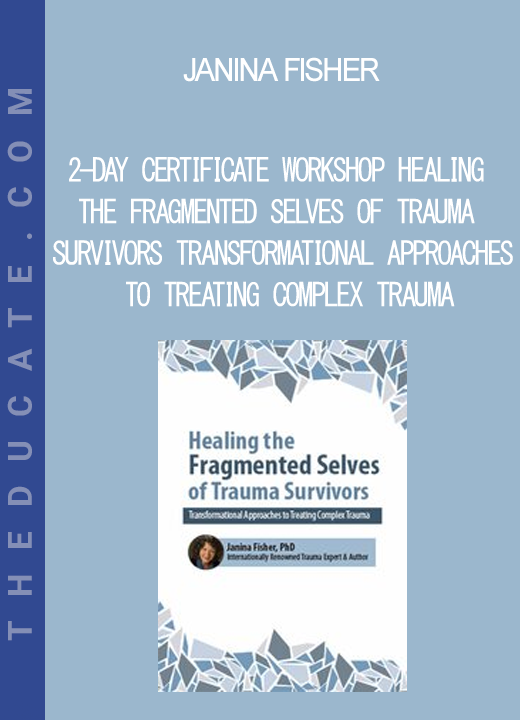Description
2-Day Certificate Workshop Healing the Fragmented Selves of Trauma Survivors: Transformational Approaches to Treating Complex Trauma – Janina Fisher
Because trauma lives in the body, traditional talk therapy cannot access the deeply rooted, pervasive wounds that complex trauma leaves behind. Many traumatized clients present with overlapping symptoms including self-hatred, self-alienation, addiction, internal conflict, numbing or shame.
With these clients, you may constantly feel stuck treating surface-level symptoms or the “crisis of the week.” As a result, you are left overwhelmed and frustrated that you can never get to treating the trauma, despite your best efforts.
Go beyond symptom reduction and take your work with traumatized clients to a whole new level by implementing this transformational approach to trauma treatment.
Watch world-renowned complex trauma and attachment expert Janina Fisher for this certificate workshop. Her cutting-edge approach will shift your clinical perspective so you’ll see your client not as a traumatized whole person, but rather as fragmented pieces that are in need of healing.
In this recording, Janina will teach you to go beyond treating surface-level symptoms and give you the tools you need to look at trauma treatment through a whole new lens. Janina’s innovative approach integrates Sensorimotor Psychotherapy, Internal Family Systems and Ego State Therapy to get to the root of the problem where trauma can truly be processed.
Janina will teach you how to help clients struggling with suicidal and self-destructive impulses, loss of identity, and self-hatred caused by childhood trauma. You’ll walk away with the skills you need to help your fragmented and traumatized clients achieve self-compassion and acceptance of all aspects of self.
Through real-life, in-session videos, practical mindfulness exercises, and unique insight from the field of neuroscience, you’ll learn powerful strategies to use in your practice to overcome the devastating impacts of childhood abuse and repair childhood wounds.
Earn your certificate and revolutionize the way you treat trauma!
- Utilize clinical strategies to identify signs and symptoms of fragmentation and internal conflict.
- Teach clients to apply non-judgmental language to their trauma-related symptoms and inner experience.
- Facilitate increased mindfulness-based dual awareness in clients to decrease client phobias of emotion and inner experience.
- Foster the development of mindful observation of fragmented parts of the self in clients.
- Utilize somatic interventions for regulating autonomic arousal and affect dysregulation to calm the body as it relates to clinical treatment.
- Integrate interpersonal neurobiology and social engagement techniques in session to improve treatment outcomes.
- Drive the growth of empathy for wounded child parts of the self to increase self-compassion in clients.
- Transform traumatic memory in clients using somatic, visualization, and ego-state techniques.
- Utilize clinical strategies to foster ‘earned secure attachment’ in a clinical setting.
- Facilitate client use of internal communication to improve treatment outcomes.
- Employ the language of parts, mindfulness strategies and unblending techniques to alleviate the symptoms of shame, depression, suicidality or shutdown.
- Apply strategies from Internal Family Systems and Sensorimotor Psychotherapy in session to aid in the repair of internal attachment.
Trauma & Attachment
- Neglect, abuse & attachment formation
- Traumatic attachment
- Early attachment & shaping attachment to self
- Internal attachment styles
Fragmentation an Adaption to Trauma
- Identify manifestations of self-alienation
- Recognize self-alienation as a survival strategy
- Split brain & conflicting defensive strategies
- Primary structural dissociation vs. secondary
- What to do when the parts highjack the body
- Repair internal attachments
- Help clients overcome the challenge of self-acceptance
Sensorimotor Psychotherapy and Fragmentation
- Sensorimotor principles of treatment
- Prerequisites for successful treatment
- Mindfulness & psychoeducation
- Implications of procedurally learned patterns
- Autonomic adaptation
- Teach clients skills to regulate arousal
- Somatic resources for traumatic reactions
How the Parts Dominate: Blending
- The questions trauma survivors don’t know to ask
- Blending Unblending: step-by-step
- Sensorimotor approaches to unblending
Internal Family Systems: Befriending our Parts
- Awaken an observer
- Help clients achieve distance from symptoms
- Decoding: identify parts
- Speak the language of parts to decrease phobia of traumatized parts
- Encourage self-leadership
Connecting to One’s Parts for Inner Healing
- Recognize the role each part plays in survival
- Assist clients with learning to “ask inside”
- Facilitate internal communication
- What does each part need?
- Establish relationships with parts
- Cultivate empathy for the parts
- The befriending questions
From Alienation to Attachment
- Rupture & repair of internal attachment
- Provide missing experiences for parts
- Role of mentalization
- Requirements of integration
- What to do when clients get highjacked
- Utilize the Social Engagement system
DOWNLOAD INSTANTLY
PLEASE CHECK ALL CONTENTS OF THE COURSE BELOW!








Reviews
There are no reviews yet.